Indoor plants not only add a touch of nature to your living space but also offer numerous health benefits. Among the various areas of your home, the bedroom is where you spend a significant portion of your time resting and rejuvenating. Therefore, selecting the right plants for this space is essential to enhance your well-being. In this article, we’ll explore the seven best bedroom plants that can significantly improve your health and wellness.

1. Snake Plant
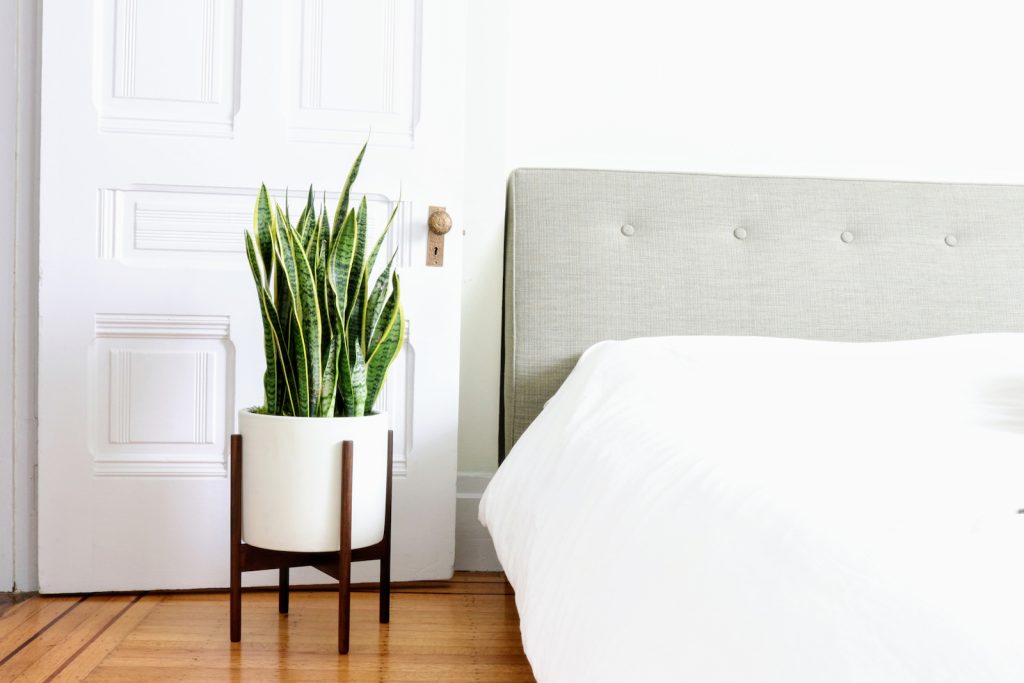
Also known as mother-in-law’s tongue, the snake plant is a popular choice for bedrooms due to its air-purifying abilities. It releases oxygen at night, making it an ideal plant for improving indoor air quality while you sleep. Additionally, snake plants are low-maintenance and can tolerate low light levels, making them perfect for bedrooms with minimal sunlight.
Health Benefits
Air purification: Snake plants are excellent at removing toxins such as formaldehyde, xylene, and toluene from the air, promoting cleaner indoor air quality.
Night oxygen production: Unlike most plants that release oxygen during the day, snake plants release oxygen at night, making them ideal for bedrooms to improve sleep quality.
Care Tips
Low light: Snake plants can thrive in low light conditions, making them suitable for bedrooms with limited sunlight.
Minimal water: Allow the soil to dry between waterings to prevent root rot. Overwatering can be detrimental to snake plants.
Living With Children And Pets
Toxicity: Snake plants contain toxic compounds that can cause gastrointestinal upset if ingested by pets or children. Keep them out of reach or opt for pet-safe alternatives if you have curious pets or young children in the home.
What I Likes
Low maintenance: Snake plants require minimal care and are tolerant of neglect, making them perfect for busy individuals or those new to plant care.
Drought tolerant: They can withstand periods of drought, making them resilient to fluctuations in watering schedules.
What I Dislikes
Toxicity: Snake plants are toxic to pets if ingested, so they should be kept out of reach of animals.
Limited growth: While slow growth can be an advantage for some, others may find it frustrating if they desire a rapidly growing plant.
2. Peace Lily

The peace lily is another excellent option for bedroom plants, renowned for its ability to remove toxins like formaldehyde and benzene from the air. It also adds a touch of elegance with its lush green leaves and delicate white flowers. Peace lilies thrive in low to moderate light and require regular watering to keep the soil moist but not soggy.
Health Benefits
Air purification: Peace lilies are effective at removing common household toxins such as formaldehyde, benzene, and ammonia from the air, promoting better indoor air quality.
Humidity control: They release moisture into the air through their leaves, increasing humidity levels and creating a more comfortable environment.
Care Tips
Indirect light: Peace lilies prefer bright, indirect light but can tolerate low light conditions. Direct sunlight can scorch their leaves.
Regular watering: Keep the soil consistently moist but not waterlogged. Wilting leaves indicate underwatering, while yellow leaves may signal overwatering.
Living With Children And Pets
Toxicity: Peace lilies contain calcium oxalate crystals, which can cause oral irritation, drooling, vomiting, and difficulty swallowing if ingested by pets or children. Keep them out of reach or choose safer alternatives for homes with curious pets or young children.
What I Likes
Blooms: Peace lilies produce elegant white flowers that add beauty and freshness to any room.
Easy to propagate: They can be easily propagated by dividing the plant, allowing you to expand your collection or share with friends.
What I Dislikes
Toxicity: Peace lilies are toxic to pets and humans if ingested, so caution should be exercised when handling them.
Sensitivity to chemicals: They are sensitive to chemicals commonly found in tap water, such as chlorine and fluoride, which can damage their leaves.
3. Aloe Vera

Aloe vera is not only a beautiful plant but also has numerous health benefits. It contains a gel-like substance that has soothing properties, making it ideal for treating minor burns, cuts, and skin irritations. In addition to its medicinal uses, aloe vera purifies the air by removing harmful pollutants, making it a perfect addition to your bedroom.
Health Benefits
Medicinal properties: Aloe vera gel has soothing and healing properties, making it effective for treating burns, cuts, and minor skin irritations.
Air purification: Aloe vera plants help remove formaldehyde and benzene from the air, contributing to a healthier indoor environment..
Care Tips
Bright light: Place aloe vera plants in bright, indirect sunlight to encourage healthy growth. Too much direct sunlight can cause sunburn.
Sparse watering: Allow the soil to dry out completely between waterings, as aloe vera plants are drought tolerant and susceptible to root rot if overwatered.
Living With Children And Pets
Toxicity: Aloe vera contains compounds that can cause gastrointestinal upset, including vomiting and diarrhea, if ingested by pets or children. Keep them out of reach or opt for safer alternatives if you have curious pets or young children in the home.
What I Likes
Multi-purpose: Aloe vera plants serve both decorative and medicinal purposes, making them a valuable addition to any home.
Low maintenance: They require minimal care and can thrive in various environmental conditions, making them suitable for beginners.
What I Dislikes
Susceptibility to frost: Aloe vera plants are sensitive to cold temperatures and should be protected from frost during the winter months.
Limited aesthetic appeal: While prized for their medicinal benefits, some may find aloe vera plants less visually appealing compared to flowering varieties.
4. English Ivy
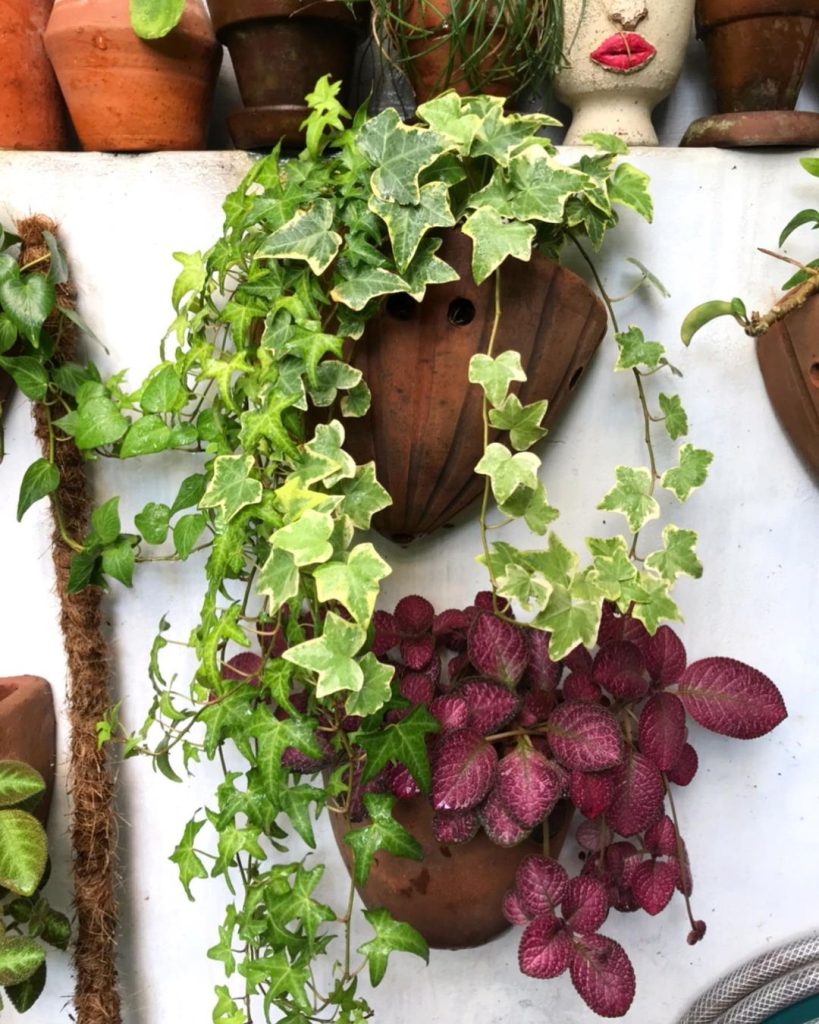
English ivy is a versatile plant that can be grown as a hanging vine or trained to climb along trellises and walls. It is highly effective at filtering airborne toxins and has been shown to reduce mold levels in indoor environments. English ivy prefers bright, indirect light and moderate humidity, making it suitable for bedrooms with adequate sunlight.
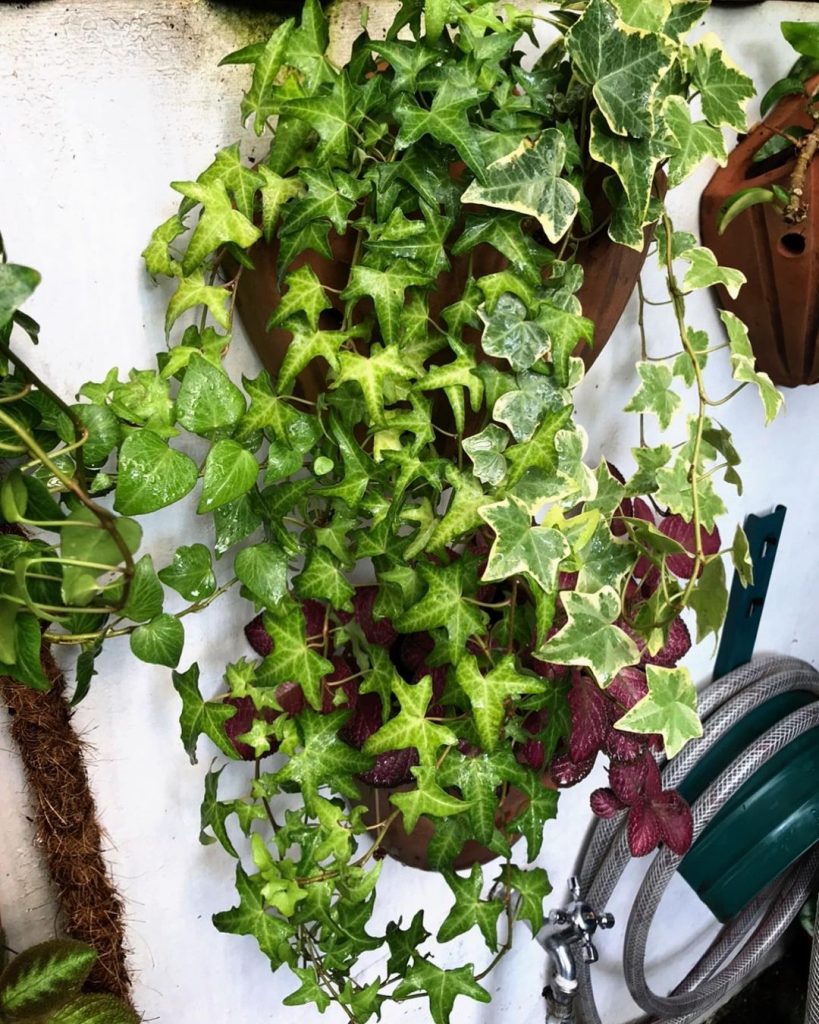
Health Benefits
Air purification: English ivy effectively filters airborne toxins such as mold spores, formaldehyde, and benzene, improving indoor air quality.
Reduced allergens: By trapping allergens and dust particles in its foliage, English ivy can alleviate allergy symptoms and respiratory issues.
Care Tips
Bright light: Provide English ivy with bright, indirect sunlight to maintain healthy growth. However, they can also tolerate low light conditions.
Regular pruning: Trim back leggy growth and remove dead or yellowing leaves to promote new growth and prevent pests and diseases.
Living With Children And Pets
Toxicity: English ivy contains compounds that can cause gastrointestinal upset if ingested by pets or children. Keep them out of reach or opt for pet-safe alternatives if you have curious pets or young children in the home.
What I Likes
Versatility: English ivy can be grown as a trailing vine or trained to climb along trellises, walls, and other structures, offering various decorative possibilities.
Easy propagation: They can be propagated easily from stem cuttings, allowing you to expand your ivy collection or share with others.
What I Dislikes
Invasive tendencies: English ivy can become invasive if not properly contained, spreading rapidly and displacing native plant species in outdoor environments.
Toxicity: All parts of the English ivy plant are toxic if ingested, so caution should be exercised around pets and children.
5. Spider Plant
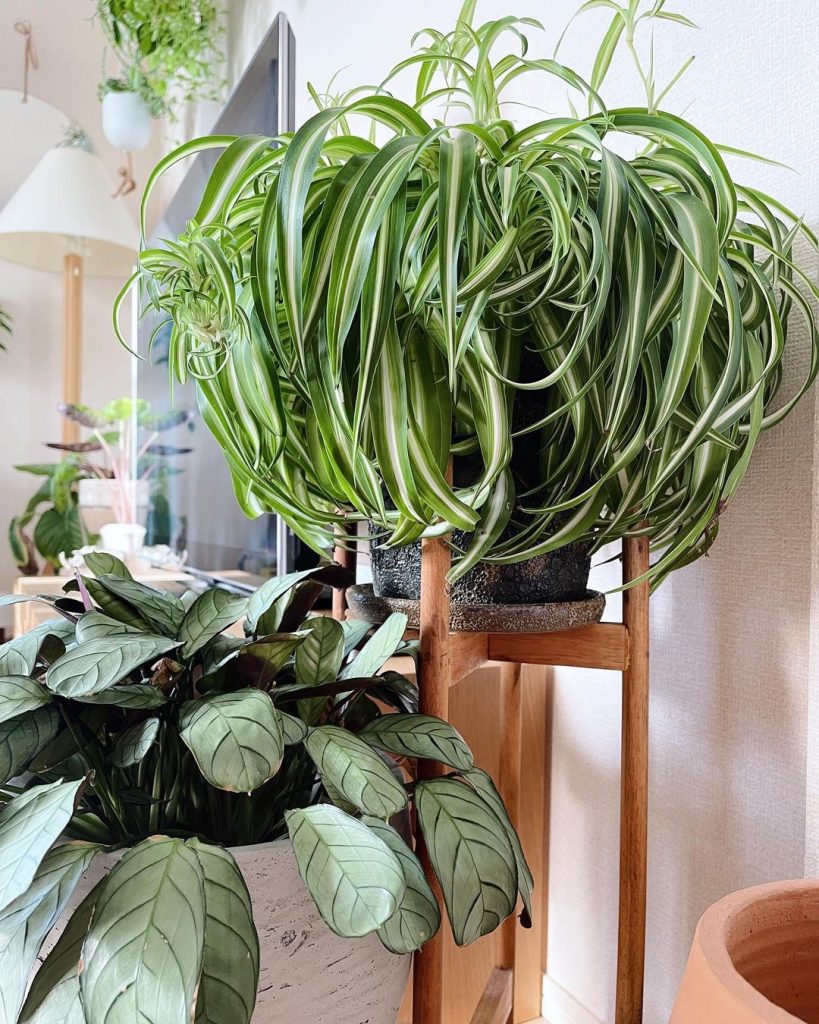
The spider plant is known for its air-purifying qualities and ease of care, making it an ideal choice for beginners. It produces oxygen while absorbing carbon monoxide and other toxins from the air, creating a healthier indoor environment. Spider plants thrive in bright, indirect light and prefer to be watered regularly but not overwatered.
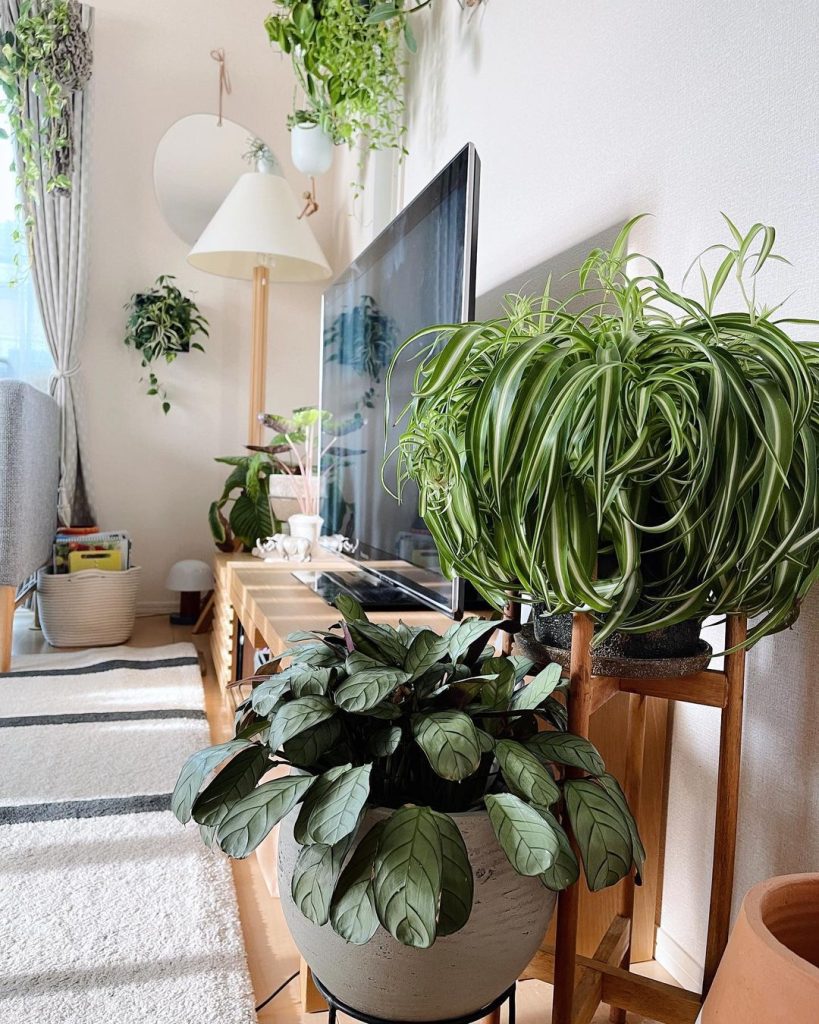
Health Benefits
Air purification: Spider plants remove harmful pollutants such as formaldehyde, carbon monoxide, and xylene from the air, promoting cleaner indoor air quality.
Easy propagation: They produce baby spider plants, or “spiderettes,” that can be propagated to create new plants, making them perfect for sharing with friends and family.
Care Tips
Indirect light: Spider plants prefer bright, indirect sunlight but can tolerate low light conditions. Direct sunlight can scorch their leaves.
Regular watering: Keep the soil evenly moist during the growing season, but allow it to dry out slightly between waterings in winter.
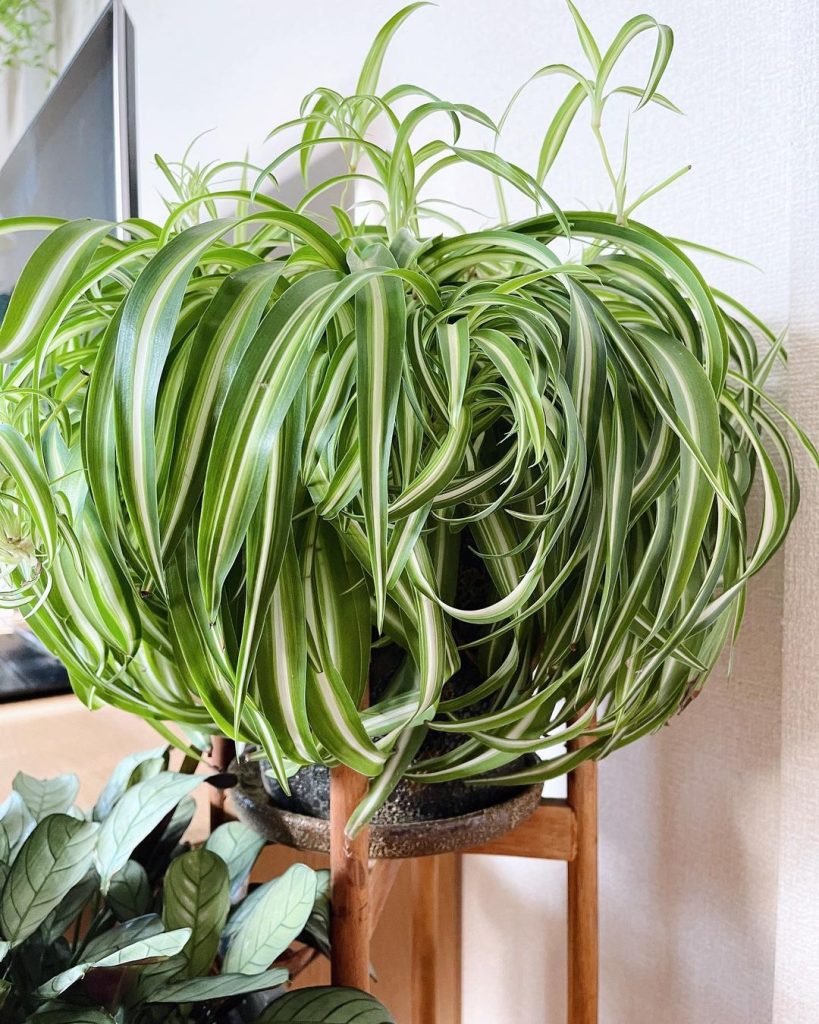
Living With Children And Pets
Non-toxic: Spider plants are safe for pets and humans, making them a pet-friendly option for households with animals.
Curiosity appeal: The dangling spiderettes can attract children and pets, so caution should be exercised to prevent accidental ingestion or damage to the plant.
What I Likes
Non-toxic: Spider plants are safe for pets and humans, making them a popular choice for households with animals and children.
Variegated foliage: They feature attractive variegated leaves that add visual interest to any space, making them a favorite among indoor plant enthusiasts.
What I Dislikes
Susceptibility to pests: Spider plants are prone to infestations by spider mites, aphids, and mealybugs, requiring regular inspection and treatment.
Brown tips: Improper watering or low humidity levels can cause the tips of spider plant leaves to turn brown, detracting from their overall appearance.
6. Lavender

Lavender is prized for its delightful fragrance and calming properties, making it perfect for promoting relaxation and better sleep. Placing a lavender plant on your bedside table or windowsill can help reduce stress and anxiety, allowing you to unwind and enjoy a restful night’s sleep.
Health Benefits
Aromatherapy: Lavender has a calming fragrance that can help reduce stress, anxiety, and promote relaxation, making it perfect for bedrooms and relaxation spaces.
Sleep aid: Inhaling lavender scent has been shown to improve sleep quality and duration, making it an excellent natural remedy for insomnia.
Care Tips
Full sun: Lavender plants thrive in full sunlight, so place them in a sunny window or outdoors in a sunny spot.
Well-drained soil: Plant lavender in well-drained soil to prevent root rot, as they are sensitive to waterlogged conditions.
Living With Children And Pets
Non-toxic: Lavender is non-toxic to pets and humans, making it safe to have around pets and children.
Fragrant attraction: The pleasant scent of lavender may attract pets, so monitor their interactions to prevent ingestion or damage to the plant.
What I Likes
Fragrant blooms: Lavender produces beautiful purple flowers that emit a delightful fragrance, attracting pollinators like bees and butterflies to the garden.
Drought tolerant: Once established, lavender plants are drought tolerant and require minimal watering, making them suitable for xeriscaping and water-wise gardens.
What I Dislikes
Short-lived: Lavender plants have a relatively short lifespan compared to other perennial herbs, typically lasting 5-10 years before needing replacement.
Winter protection: Lavender is not cold hardy and may require winter protection in regions with harsh winters, such as mulching or covering with frost cloth.
7. Bamboo Palm

The bamboo palm, also known as the reed palm, is a tropical plant that can add a touch of paradise to your bedroom. It is highly effective at filtering indoor air pollutants like formaldehyde and benzene, making it beneficial for your health. Bamboo palms thrive in bright, indirect light and require regular watering to keep the soil consistently moist.
Health Benefits
Air purification: Bamboo palms are effective at removing indoor air pollutants such as formaldehyde, benzene, and trichloroethylene, improving air quality.
Humidification: They release moisture into the air through transpiration, increasing humidity levels and alleviating dry indoor conditions.
Care Tips
Indirect light: Place bamboo palms in bright, indirect sunlight to prevent leaf burn. They can tolerate low light conditions but may become leggy.
Regular watering: Keep the soil consistently moist but not waterlogged, as bamboo palms prefer slightly damp soil.
Living With Children And Pets
Non-toxic: Bamboo palms are non-toxic to pets and humans, making them safe to have around pets and children.
Attractive foliage: The lush, tropical foliage of bamboo palms may attract pets, so monitor their interactions to prevent ingestion or damage to the plant.
What I Likes
Tropical aesthetic: Bamboo palms have a lush, tropical appearance with feathery fronds that add a touch of exotic flair to any interior space.
Low toxicity: They are non-toxic to pets and humans, making them a safe option for households with animals and small children.
What I Dislikes
Space requirements: Bamboo palms can grow quite large over time, requiring ample space to accommodate their mature size. They may outgrow smaller living spaces.
Pest susceptibility: They are susceptible to infestations by spider mites, scales, and mealybugs, especially when grown indoors under dry conditions.
Benefits of Bedroom Plants
Bedroom plants offer a multitude of benefits beyond just adding a touch of greenery to your living space. Here are some of the key advantages of incorporating plants into your bedroom:
Improved Air Quality: One of the most significant benefits of bedroom plants is their ability to purify the air by absorbing carbon dioxide and releasing oxygen through photosynthesis.
Additionally, certain plants have been shown to filter out harmful toxins and pollutants such as formaldehyde, benzene, and trichloroethylene, which are commonly found in indoor environments. By improving air quality, bedroom plants create a healthier and more breathable atmosphere, reducing the risk of respiratory problems and allergies.
Enhanced Sleep Quality: Many bedroom plants release oxygen at night, making them ideal companions for a restful night’s sleep. Increased oxygen levels in the bedroom can promote relaxation, reduce stress, and improve sleep quality, helping you wake up feeling refreshed and rejuvenated.
Additionally, the presence of plants can create a calming and soothing environment conducive to better sleep, making it easier to unwind and drift off into a peaceful slumber.
Stress Reduction: Studies have shown that being around plants can have a positive impact on mental health and well-being, helping to reduce stress, anxiety, and depression.
The act of caring for plants and nurturing them can be therapeutic and meditative, providing a sense of purpose and connection to nature.
Simply being surrounded by greenery can evoke feelings of tranquility and serenity, creating a peaceful sanctuary within your bedroom where you can escape from the stresses of daily life.
Increased Productivity and Concentration: Indoor plants have been found to boost productivity and concentration levels, making them valuable additions to home offices or study areas within the bedroom.
The presence of plants can help to improve cognitive function, memory retention, and focus, leading to greater efficiency and creativity in your work or studies. Additionally, plants have been shown to reduce fatigue and eyestrain, creating a more conducive environment for extended periods of work or study.
Mood Enhancement: Bringing nature indoors can have a positive impact on mood and emotional well-being, uplifting spirits and fostering a sense of happiness and contentment.
The vibrant colors, textures, and fragrances of plants can stimulate the senses and evoke feelings of joy and pleasure, creating a more vibrant and dynamic living environment.
Whether it’s the sight of colorful blooms, the scent of fragrant flowers, or the touch of velvety leaves, bedroom plants have the power to elevate mood and create a sense of beauty and harmony in your personal space.
Bedroom plants offer a myriad of benefits that go beyond mere aesthetics, enhancing air quality, promoting better sleep, reducing stress, improving productivity, and boosting mood and well-being.
Placement Suggestions
When it comes to placing your bedroom plants, consider the following suggestions for optimal health benefits and aesthetic appeal:
- On bedside tables or windowsills: Placing plants near your bed allows you to enjoy their air-purifying benefits while you sleep. Opt for smaller plants or succulents on bedside tables to avoid overcrowding.
- In hanging planters or wall-mounted holders: Utilize vertical space by hanging plants in macramé holders or wall-mounted planters. This not only saves space but also adds visual interest to your bedroom decor.
- Near electronic devices or furniture: Position plants near electronic devices such as computers or televisions to help absorb electromagnetic radiation. Additionally, placing plants near furniture can soften harsh lines and create a more inviting atmosphere.
- In decorative pots or containers: Choose pots or containers that complement your bedroom decor style. Whether it’s sleek ceramic pots, rustic terracotta planters, or modern geometric containers, the right vessel can enhance the overall aesthetic appeal of your plants.
Common Mistakes to Avoid
To ensure the health and longevity of your bedroom plants, avoid the following common mistakes:
- Overwatering: One of the most common mistakes is overwatering plants, which can lead to root rot and fungal diseases. Always check the soil moisture before watering and adjust the frequency based on the plant’s specific needs.
- Placing plants in direct sunlight or drafty areas: While some plants thrive in bright, indirect light, others can suffer from sunburn or temperature fluctuations if placed in direct sunlight or drafty areas. Be mindful of your plant’s light and temperature requirements to prevent damage.
- Neglecting to dust plant leaves regularly: Dust can accumulate on plant leaves, obstructing their ability to photosynthesize and potentially attracting pests. Wipe down your plant’s leaves regularly with a damp cloth to remove dust and keep them healthy.
- Using chemical-based fertilizers or pesticides: Chemical-based fertilizers and pesticides can harm beneficial microorganisms in the soil and negatively impact plant health. Opt for organic or natural alternatives whenever possible to promote a healthy and sustainable environment for your plants.
- Ignoring signs of pests or diseases: Be vigilant for signs of pests or diseases on your plants, such as yellowing leaves, brown spots, or webbing. Address any issues promptly by isolating affected plants, pruning affected areas, or using natural pest control methods to prevent further spread.
Conclusion
Incorporating bedroom plants into your home decor is not only aesthetically pleasing but also beneficial for your health and well-being.
By choosing the right plants and providing proper care, you can enjoy cleaner air, reduced stress, and better sleep quality.
Whether you prefer low-maintenance succulents or fragrant herbs, there’s a plant out there to suit your style and needs. So why wait? Bring the beauty of nature